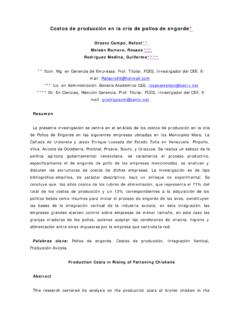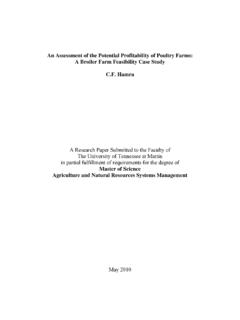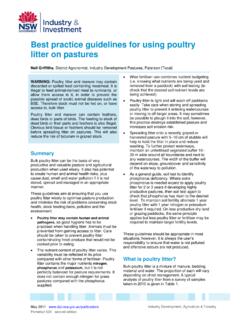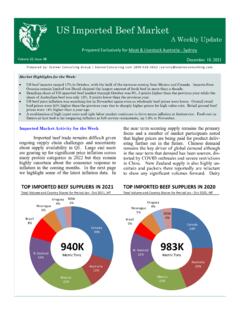Transcription of CSEC Agricultural Science SBA Teachers' Training Manual
1 Government of the Republic of Trinidad and Tobago MINISTRY OF EDUCATION CURRICULUM PLANNING AND DEVELOPMENT DIVISION csec Agricultural Science SBA Teachers' Training Manual csec Agricultural Science Syllabus 2018 by Karen Ramdahin-Nandaram Khalel Mohoyodeen May 2017 1 Ministry of Education Published in 2017 by the Curriculum Planning & Development Division Ministry of Education Rudranath Capildeo Learning Resource Centre Mc Bean, Couva Republic of Trinidad & Tobago 2 Table of Contents Foreword .. 0 Acknowledgements .. 1 About this book .. 2 SECTION 1: SAMPLE CROP INVESTIGATIVE PROJECT .. 3 INTRODUCTION .. 5 Background .. 5 Problem Statement.
2 5 5 Aim .. 5 METHODOLOGY .. 6 Materials, Tools and Equipment .. 6 Experimental Design .. 6 Data Collection .. 6 Crop production Practices .. 7 RESULTS .. 11 Plant Survival .. 11 Average Number of Leaves per Plant .. 11 Yield .. 12 DISCUSSION .. 14 Plant Survival .. 14 Average Number of Leaves per Plant .. 14 Yield .. 14 CONCLUSION, RECOMMENDATIONS AND LIMITATIONS .. 15 Conclusion .. 15 Recommendations .. 15 Limitations .. 15 REFERENCES .. 16 COST 17 Complete Budget .. 17 Actual Income-Expenditure Statement .. 18 Comparison of Projected and Actual Income, Expenditure and Profit/Loss .. 19 APPENDIX 1: DATA COLLECTION SHEETS FOR CROP INVESTIGATION .. 21 Plant Survivability .. 21 3 Number of Leaves per Plant .. 22 Fresh Weight of Harvested Crop.
3 23 APPENDIX 2: DRAFT MARK SCHEME FOR CROP 24 PART 2: SAMPLE LIVESTOCK INVESTIGATIVE PROJECT .. 25 INTRODUCTION .. 27 Background .. 27 Problem Statement .. 27 27 Aim .. 27 METHODOLOGY .. 28 Materials, Tools and Equipment .. 28 Experimental Design .. 28 Data Collection .. 28 Broiler production Practices .. 29 RESULTS .. 31 Broiler Liveability .. 31 Feed Consumption .. 31 Broiler Live Weight .. 32 Feed Conversion Ratio (FCR).. 33 Other Observations .. 34 DISCUSSION .. 35 Broiler Liveability .. 35 Feed Consumption .. 35 Broiler Live Weight .. 35 Feed Conversion Ratio (FCR).. 35 Other Observations .. 35 CONCLUSION, LIMITATIONS AND RECOMMENDATIONS .. 37 Conclusion .. 37 Recommendation .. 37 Limitations .. 37 REFERENCES.
4 38 COST 39 Complete Budget .. 39 Actual Income-Expenditure Statement .. 40 4 Comparison of Projected and Actual Income, Expenditure and Profit/Loss .. 41 APPENDIX 1: DATA COLLECTION SHEET FOR BROILER INVESTIGATION .. 43 Broiler Feed Consumption .. 43 Broiler Survival .. 44 Broiler Live Weight .. 45 APPENDIX 2: DRAFT MARK SCHEME FOR LIVESTOCK INVESTIGATION .. 46 Foreword The Curriculum Planning and Development Division is pleased to develop this document as instructional material, intended to guide secondary school Agricultural Science teachers in the csec Agricultural Science School-Based Assessment (SBA). From 2018, the SBA portfolio requirements will be changed to investigative projects in crop and livestock production .
5 Teachers have been clamouring for assistance in the implementation of the SBA to meet these new requirements. To this end, the Curriculum Planning and Development Division has been proactive in producing this document with the hope that it will positively contribute to teachers professional development as well as students academic success in csec Agricultural Science in Trinidad and Tobago and the wider Caribbean. John Roopchan Director Curriculum Development Curriculum Planning & Development Division 1 Acknowledgements The authors acknowledge with gratitude the assistance of the Agricultural Science Teachers and Students of Arima North, Chaguanas South and Cunupia Secondary Schools for many of the pictures used in this Teachers' Training Manual .
6 Thanks to all the secondary school Agricultural Science Teachers for your invaluable feedback at the 2017 csec Agricultural Science SBA Training Workshops. Thanks also to Ms. C. Ramsundar and Ms. Sharda Maharaj, Supervisor, School Broadcasting Unit for assistance in editing this document; Ms. Donelia Richards, Illustrator for graphic support and Clerk Typists Mrs. Dianne Ramnarace-Singh and Ms. Nirmala Harry-Bachan, for assistance with the printing of this document. 2 About this book This book is intended as a guide to assist csec Agricultural Science teachers and students with the changes in the SBA requirements for the crop and animal production investigations in the revised csec Agricultural Science Syllabus which will be examined in 2018.
7 It contains two sample SBAs, a crop and a livestock investigative project, as well as sample data collection sheets and a draft mark scheme for marking these investigative reports. Section 1 contains the sample crop production investigative report and Section 2 is the sample livestock investigative report. It is hoped that teachers would use the information in this Guide to assist their students in meeting the requirements for the csec Agricultural Science SBA investigative projects. Furthermore, teachers are encouraged to develop their own investigative projects in collaboration with their students. Karen Ramdahin-Nandaram Curriculum Officer ( Agricultural Science ) Khalel Mohoyodeen Curriculum Coordinator (TVET) 3 SECTION 1 SAMPLE CROP INVESTIGATIVE PROJECT 4 FREEPORT HIGH SCHOOL csec Agricultural Science (Single Award) Investigative Report CROP INVESTIGATIVE PROJECT Name of Student: KAY MIKE Student Registration No.
8 : 1234567890 Name of School: FREEPORT HIGH SCHOOL Title of Project: The Response of Pakchoi Plants to Fertilizer Application in a Clayey Loam Soil at Freeport High School, Trinidad & Tobago Project Start Date: 1st November 2016 Project End Date: 15th December 2016 5 INTRODUCTION Background Pakchoi (Brassica chinensis) also known as Chinese cabbage is a leafy vegetable which is grown throughout Trinidad and Tobago. This crop can be eaten either cooked or raw. In Trinidad and Tobago, it is cooked and eaten as a green vegetable. Its leaves are rich in vitamins, minerals and dietary fibre (Ministry of Food production , Land and Marine Affairs 2009). Many varieties of pakchoi are grown in Trinidad and Tobago.
9 Two common varieties grown are Joi Choi and Spoon Blade (Ministry of Food production , Land and Marine Affairs 2009). Pakchoi vary in growth habit, agronomic practices and yield. Yields for pakchoi range from 4,988 to 29,927 kg/ha (Wanitprapha et al. 1992). A review of the literature on pakchoi reveals a range of agronomic practices for growing this crop. These practices vary according to the cultivar, soil type and environmental conditions (Ministry of Food production , Land and Marine Affairs 2009; Weever et al. 1998; Wanitprapha et al. 1992). In Trinidad and Tobago, there are basically two methods of growing pakchoi: (a) growbox method and (b) field production . Growbox cultivation methods are described in The Growbox System for Vegetables: A Producer s Manual (Ministry of Agriculture, Lands and Marine Resources (2005).)
10 Field cultivation for pakchoi is described in Weever et al. (1998). There are no guidelines for growing pakchoi at our school, and it has become necessary to develop guidelines for the growing of pakchoi at Freeport High School. This investigation was done to determine the response of pakchoi to fertilizer application at Freeport High School which has a clayey loam soil. Problem Statement The yield of pakchoi varies widely with crop production practices but the response of pakchoi to fertilizer application at Freeport High School is not known. Hypothesis Fertilizer application increases yield in pakchoi. OR The application of fertilizer to pakchoi increases yield. OR The yield of pakchoi increases with fertilizer application.







